Media Practice & Operations Director
Holiday Guide 2022: Are you ready?
Media Practice & Operations Director
For the digital industry, 2022 was filled with big changes: the gradual withdrawal of cookies, laws governing privacy, inflation, post-pandemic behavioural changes (particularly when it comes to online vs. in-store purchasing), as well as constant growth in algorithmic and marketing automation capacities.
Here are a few of the important things we learned from the 2021 holiday period, supported by the incisive statistics presented in Google Think Holiday 2022:
- The holiday shopping period started earlier and lasted longer.
- 50% more purchases than in 2021 made before the first week of November.
- 50% more purchases than in 2021 made before the first week of November.
- Online sales are growing.
- 61% of holiday purchases were made online and 94% were purchased in-store after first performing an online search.
- 61% of holiday purchases were made online and 94% were purchased in-store after first performing an online search.
- It’s becoming increasingly harder for consumers to obtain the products they’re looking for.
- 29% of people were not able to buy the items they wanted because they were no longer available.
N.B. All the statistics presented in this article were taken from Google Think Holiday 2022. This document is available at Google Think Holiday 2022. The statistics cover all Canadian markets and provide a comparison with data collected in 2021.
While our industry is transforming before our very eyes, shaped by deep changes, what should we do to adequately prepare for the holiday period, knowing that it’s a decisive quarter for most businesses?
We created this guide in the hopes it will answer your questions and help you prioritize your activities as the next quarter launches. Here you’ll find points of view from experts in user experience, marketing analytics, email marketing and media.
User experience
In recent years, the user journey has evolved a lot. But what’s coming in 2022, after all the changes we’ve seen caused by the pandemic? How can we ensure we have an appropriate digital strategy for today’s user journey?
Here are a few data points to clarify these issues:
Subscriptions to different services (Dollar Shave Club, Essentials Eco, Hello Fresh, Spark Box, etc.) are becoming increasingly popular holiday gifts.
- 37% of consumers intend to purchase at least one type of subscription this year as a holiday gift.
- 40% of consumers state they are more likely than last year to offer a subscription as a gift.
Many people intend to buy their holiday gifts earlier than in the past. After dealing with the supply chain issues of the past two years, consumers seem to have learnt their lesson.
- 1 Canadian in 5 has already started their holiday shopping.
- 36% of Canadians state they’re open to hearing about holiday promotions and gift ideas starting today.
Advertisers also need to adapt to this new reality.
An increase in competition for ad space of between 30% and 100% is forecast compared to the previous year. The month of November will undoubtedly be the most competitive of the year in the advertising sector.
For consumers, online and offline reality is the same. Their goal is to obtain the products they want. That’s it. It’s just that simple.
Your marketing strategy should therefore be adapted to this indifference, rather than privileging one or the other of these modes of purchase in the user journey you are offering. After the two-year pandemic, your digital assets now represent a gateway to omnichannel consumers. Optimize your marketing strategy to take advantage of your sales, whether online or offline! Be present throughout the user journey, regardless of the channel they choose to use.
- 9 out of 10 consumers indicate they will search online before visiting stores.
- Consumers on an omnichannel journey generate two times the value for your business (versus users who go to stores directly without searching online or simply buying online).
Your consumers’ loyalty will be at its weakest level in recent years.
Due to the inflation we’re currently experiencing, consumers will be even more sensitive to the prices of products and services this year. Now more than ever, they’ll be searching for the best prices, irrespective of the brand of the product or the seller.
In order to differentiate yourself from your competitors, you need to display/post very competitive prices and also offer consumers added value for the product offered (for example, a guarantee, after-sales service, free or fast delivery, easy exchanges or refunds, etc.).
Here are a few illustrative statistics concerning the above:
- 54% of Canadians who participated in the survey indicated they had changed brands or sellers because of the price of products;
- 9 consumers out of 10 indicated they were ready to pay a higher price (a premium) if this would make the purchase experience easier;
- up to now, we’ve seen 80 times more gift searches sorted by price in 2022 than in the same period in 2021.
The importance of data measurement and activation
In terms of information and insights, a retrospective look at performance last year is always a good idea, since it provides a point of comparison (commonly called a benchmark) that provides perspective for this year’s results and allows precise measurement of advancement or regression.
If you’ve planned similar strategies to the ones you used last year, it’s important to examine last year’s performance. Ensure you’ve implemented Google Analytics 4 (GA4) on your site, since it’s highly likely to become your favourite tool in 2023.
Data precision and activation
It’s important to track the precision of your data analysis reports.
Comparing your Google Analytics reports to those from your internal systems (eCommerce, ERP) is a good habit, especially if you do this systematically. This process should be applied throughout the year, but especially during the holiday season. In general, when you perform this comparison, a ratio of 90% to 95% correlation between GA data and your own is considered an indication of reliability.
In terms of operations, we have a little warning for you: It’s highly inadvisable to launch major analytics projects around the holiday season (a period with a high level of transactions). In terms of performance measurement, a few tools such as Facebook Conversions API or Google’s Enhanced Conversions can raise the precision of conversion measurement and, simultaneously, your return on investment calculation for an ad expenditure (also called return on ad spend or ROAS).
The efficient management of audiences is a decisive factor for companies looking to increase their revenue. Developing remarketing strategies for key activities (for example, adding to the shopping cart, ending a session, etc.) is important for enhancing your return on investment (ROI) for marketing campaigns. With the disappearance of third-party cookies, it’s crucial to consider audience development strategies based on customer data (or first-party data) such as emails or phone numbers, for example. Audiences based on primary data represent the future of digital audience management in a context where anonymous identifiers (such as the infamous cookie) are slowly disappearing.
The use of statistical techniques such as attribution based on regression (or RBA, which stands for regression-based attribution) or marketing mix modelling (MMM) will become unavoidable tools for justifying the impact of marketing campaigns on company revenues.
Acquisition is good, but loyalty is even better!
In terms of customer loyalty, in 2022, companies are faced with a fairly clear picture. In general, users are:
- less loyal to brands;
- highly influenced by product prices;
- ready to pay a premium for an efficient user experience.
It is therefore essential to take advantage of your first-party data by establishing a marketing strategy adapted to the difficulties of our current context—a strategy that specifically aims to maintain the loyalty of your current customers, which was so diligently acquired by the sweat of your brow.
To this end, an effective and simple solution to put in place is email automation. You’re probably sitting on a gold mine of information that’s just waiting to be used. With email automation, you can now present your customers with the various issues they’ll need to face in 2022. Show your proactivity and sense of initiative: Adapt yourself to their user journey by contacting them to offer personalized offers in advance. This might ensure you keep your customers as 2022 comes to a close.
Here’s an article written by our relational marketing practice lead, Maxime Philippon, who explains in detail how to improve customer retention with data and segmentation.
Positively influencing conversion
Just to remind you, conversion rate optimization (CRO) is a methodology that aims to optimize a digital interface (most often, that of an e-commerce site) with the goal of increasing the number of conversions on a transactional site.
As Black Friday nears, not to mention the holiday rush, CRO is indispensable to the success of your marketing campaigns. But here’s some good news: User behaviour is different during promotional periods, when customers are fortunately less unpredictable than usual, at least in relation to the experience offered on your site.
Given this, there’s no need to try and convince them, since it’s highly likely users who visit your platform are already interested in buying one of your products or services! The crux is instead shopping cart conversion, from add-ons to payment and including all the critical phases of check-out, which you need to pay particular attention to.
Here are a few ideas for A/B testing that have proven their worth and which might help you maximize your conversion rate by improving your chances of finalizing a large number of transactions on your online platform:
Ease of adding to the shopping cart: Ensure you include a button with a call to action (CTA) “Add to cart” on each product page above the fold (for all devices types used). For accessibility reasons, it should also be in high contrast with the rest of the page and remain visible when scrolling through the page’s contents.
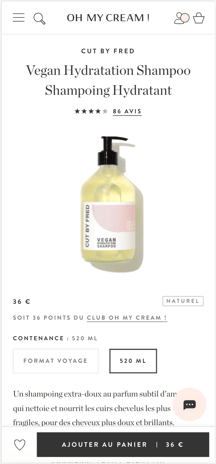
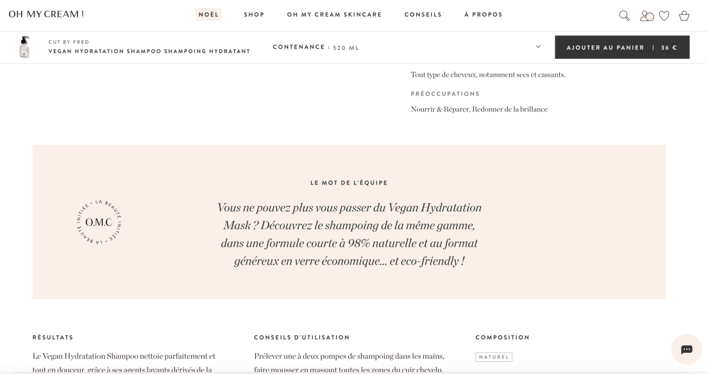
Source: Oh My Cream where the black CTA button contrasts effectively with the page’s very pale background, in addition to always remaining visible on all device types.
Add reassuring elements: The goal here is to reduce any potential anxiety users may have during the check-out process. Do you pay for returns, offer free delivery or guarantee secure payment? Display this clearly during the different key stages of the purchase journey! (Specifically the product page, adding to the shopping cart and check-out.)
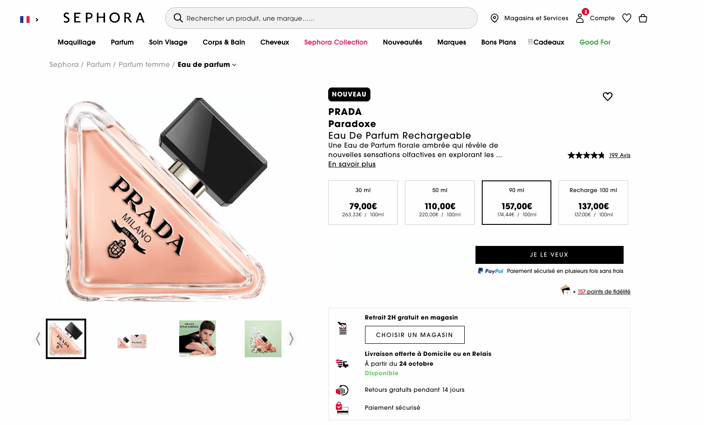
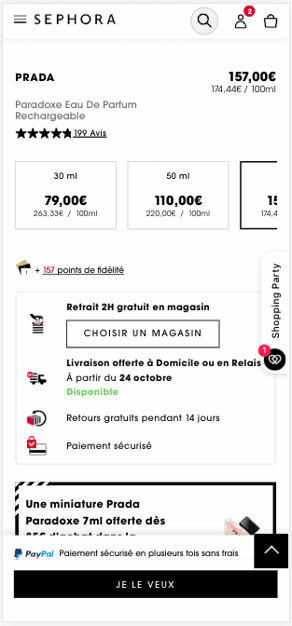
Reassuring messages, related to fast delivery, secure payments (PayPal) and free returns, are visible under the CTA (“I want it”), which is shown at all times on product pages on the Sephora website.
Use the social proof superpower: Social proof is an influence mechanism frequently used in e-commerce. It can take several forms: customer comments on a product, opinion on the service offered by a business, the addition of a “trusted” tag or mark, etc. Used to enhance a product page, this sales technique enables you to kill two birds with one stone by simultaneously inflating the add-to-cart rate and conversion rate. Studies led by Power Reviews show conversion rate increases by 120.3% when a person visits a site and interacts with the evaluations and comments displayed on the product page.
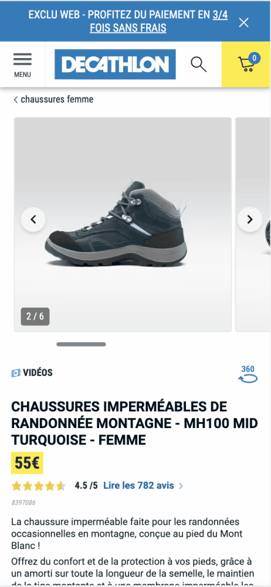
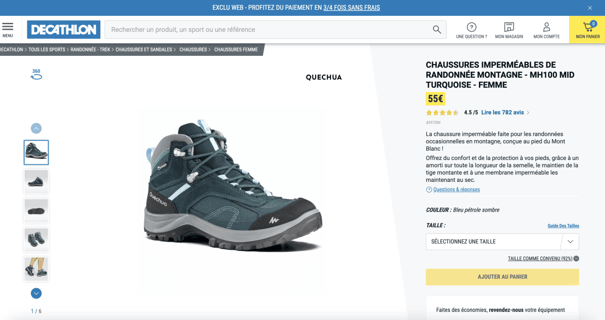
On decathlon.ca, customer comments about products on sale are displayed above the fold, a way of maximizing their visibility.
Let your customers order as a guest: The necessity of creating a personal account to complete a transaction is an impediment to purchasing. Without doubt it is one of the most common reasons explaining shopping cart abandonment, as indicated in a study led by Baymard Institute. According to this study, up to 37% of users choose to abandon their cart when they are forced to create an account to complete their purchase process. We’ve said it before and we’ll say it again: You need to keep in mind that the check-out process can be a source of anxiety for consumers. To increase your conversion rate, it’s therefore imperative that you work at improving the flow and shortening the different stages leading to payment as much as possible.
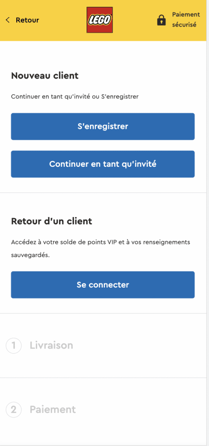
On lego.ca, the options are clear: the two call-to-action buttons are easy to see, their text is straightforward and their design (starting with the colour) contrasts perfectly with the page’s background.
Offer several payment methods: Let your customers have a choice: Imposing a payment method contributes to shopping cart abandonment, as emphasized in a quantitative study led by the Baymard Institute in 2021. The study demonstrated that 7 percent of users had abandoned a cart in the previous three months because the site didn’t offer their preferred payment option. Also, during their online purchasing, 35 percent of consumers around the world surveyed by Fedex stated they would rather use digital wallets.
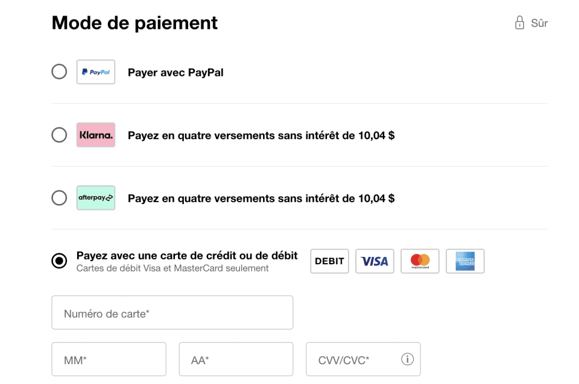
Sephora.com offers several payment methods and modalities.
Efficiently plan your media campaigns
To help you plan your holiday campaigns, here are five steps that will contribute, in our opinion, to the success of your 2022 holiday campaigns.
Step 1: Learn from past experience
The first step to a good Q4 plan is to apply everything you’ve learned from previous experiences.
By revisiting what worked well and less well in the past, you can prioritize certain more promising media activities and adapt your budget allocations in order to maximize performance.
Step 2: Think about upcoming logistical challenges
In a retail context, it’s essential to verify your inventory and delivery timelines.
Which products generate the biggest profit margins? Which products do you really need to unload? What is the cutoff date for your customers’ orders if they want to receive products they purchased before Christmas?
A good media strategy must absolutely take into account the inventory of different products you are advertising and effectively communicate the average delivery time to customers.
Taking care of these two simple measures will enable companies to maximize their profit margins and, above all, ensure excellent service for their customers.
Step 3: Align goals and promotions
This next step provides a detailed consideration of your business goals and their transposition into SMART marketing objectives.
During Q4, it’s important to define your goals properly by dividing them into key periods. This will enable you to, amongst other things, align your objectives with the promotions you plan to highlight at key moments throughout the last quarter.
For example, Black Friday and Cyber Monday will certainly represent one of the busiest weekends of the year. So you should anticipate that your profit margins will be affected by the big discounts that will be applied over that period (you need to stay competitive!).
Our crucial marketing strategies and objectives are often segmented by day in Q4 in order to foresee optimal budgeting and establish realistic targets.
Step 4: Configure and segment audiences
At this stage, you need to ensure your audience pools are properly configured and that they correctly represent the major segments of your users.
For example, if today you want to retarget users up to 30 days after they interacted during Black Friday, it might already be too late, at this time, to configure your audience and have enough data to accomplish this.
Audiences represent an extremely important data point for media activations. The more appropriate the audience pools, the better the algorithms can target the right users and contribute to maximizing your return on media investment. As we mentioned earlier, using Google Analytics 4 should be a priority this year, because the digital measurement platform offers a good number of attractive options, such as predictive audiences.
We know we tell you this a lot (and will keep doing so), but it’s becoming increasingly important to base your media strategies on your first-party audiences.
First, because of the imminent disappearance of third-party cookies and the increasing difficulty we’re having with tracking or retracing the journey of website users. Second, because the important data you’ve accumulated about your current customers contains huge learning potential that your company can greatly benefit from.
On Facebook, for example, we strongly recommend putting in place email acquisition strategies into your newsletter as the holidays approach. With a bit of forethought, you can offer the audience you hope to attract an offer that’s exclusive to this time of year.
Three reasons to create an exclusive promotional campaign before Black Friday
- To test various creative elements and promotions before Black Friday week amongst your VIP audience (regular customers, subscribers to your newsletter, your social media followers).
- To ensure this audience is primed to convert on your website before they get lost in the advertising brouhaha invariably brought on by this busy period.
- To win the loyalty of your current clientele.
Step 5: Activation of Performance Max campaigns
If you operate in the retail world and have digital marketing initiatives in place, it’s highly likely you’ve already set up the new tool offered by Google: Performance Max campaigns.
These have replaced the Smart Shopping campaigns (which were automatically transferred to Performance Max in July) as well as the local campaigns previously offered by Google. This new format provides a bit less control than its predecessors, but once you’ve mastered the tool, it offers a much more interesting return. The increased efficiency of Performance Max is notably due to its optimized use of audiences and the fact that it tracks users throughout their browsing journey across all of Google’s digital properties (Search, Shopping, Maps, Video, Discovery, Gmail, etc.).
If you work in sales, whether online or in-store, Performance Max campaigns are an indispensable part of your media mix.
To learn more about our many technical recommendations in the media field, here are a few articles we’ve published in recent years that remain relevant when it comes to preparing to meet your business objectives during this crucial time of the year.
- The Holiday Season Is a Great Time for Discovering Brands
- Expect a Historic Holiday Season in 2021
- What Will Holiday Shopping Look Like This Year?
- #BLACKFRIDAY, #CYBERMONDAY, #BOXINGDAY. Are You Ready for the Holidays?
We’re sure these articles will facilitate your thinking as the frenzy of the holiday season gets started.
Create your marketing plan ASAP
We hope the advice provided in this short holiday preparation guide will help you reach your targets and benefit from the opportunities available during this season of plenty.
To make sure luck is on your side, we encourage you to create your last-quarter marketing plan as early as you can, ensuring of course that it takes into consideration all the tips we’ve provided here.
Do you still have questions that haven’t been covered in this article? Need more targeted advice that’s adapted to the specifics of your industry?
If so, don’t hesitate to get in touch with one of our specialists, who would be happy to help you reach new heights in your business performance.




